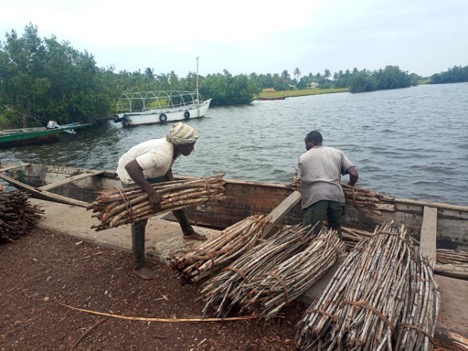NGOs lead efforts to reverse trend of unsustainable mangrove cutting in Ghana
It’s 2:00 p.m. on Monday and a canoe full of harvested mangrove has just docked at the Anyanui mangrove market by the Volta River in the Volta Region of Ghana.
More than 4000 logs of the wood –arranged in bundles – are offloaded and neatly arranged at shore ahead of the market day, Wednesday, when mega sales are expected.
Esinam Seduvor just bought the wood has about GH¢ 800 ($80) worth of harvested mangrove stocked in the market, selling each bundle of about 15 logs between GH¢5 (50 cents) and GH¢8 (80 cents).

She has been in the trade for more than five years and finds it to profitable enough to meet her daily subsistence.
“People buy a lot from us especially during the peak of the fishing season… I sell each bundle for an average of GH¢7 but for GH¢5 you can get smaller ones or GH¢8 for bigger ones.”
“The mangroves are cut by land owners and I buy from them. I also need to pay a labourer to collect them and pay a canoe to cart it from the across the river,” she said.
There is no regulatory regime that requires those who cut mangroves to be licensed.
The Anyanui market is one of the major markets within the 530 km² Keta ramsar zone, and within an hour, two cars had both received full loads of harvested mangrove for sale to customers in adjoining communities.

“Mangroves are most preferred because when you produce charcoal from them it comes out better and my customers who smoke fish say using mangroves preserve their fishes better. It is cheaper than using a gas stove,” Seduvor said.
Mangroves are small trees that grow particularly along coastlines and in brackish water. They play many critical roles in environments such as Ghana’s.
Among other things, they protect coastline from erosion, reduce flooding through absorption of excess water and provide a congenial environment for birds, crabs and fish to breed.
Despite their importance in the environment especially to the marine ecosystem, they are very fragile and greatly threatened across the world. Data by Global Forest Watch says the world lost between 22,000-62,000 acres of mangroves each year between 2001 and 2012 alone.

For Ghana, the global agroforestry platform, ICRAF, reports a net loss of 133,189 acres (539 square km) of mangroves between 2000 and 2020.
Like in Anyanui, mangroves are cut and sold as fuel wood as a major source of livelihood in many coastal communities across the country.
The Regulations Manager of the Wildlife Division under the Forestry Commission, Vincent Dickson Agyeman also revealed that human activities like indiscriminate disposal of waste have led to the blockage of canals that allows the flow of sea water into lagoons and that was negatively affecting the growth of mangroves.
“Data from satellite monitoring dating back from 2015 has shown a decline in the mangrove coverage of the Keta lagoon complex. The total mangrove area coverage has decreased from approximately 70km2 in 2015 to 58km2 in 2020,” a report by the Regional Marine Centre at the University of Ghana revealed.
The regional manager of the forestry commission, Lawrence Tetteh Ocloo said controlling the spate of unsustainable cutting of mangroves has been difficult due to the large dependence on it as a source of livelihood for the coastal dwellers however, “we do a lot of conservation education and habitat restoration in collaboration with community members and NGOs.”
In communities such as Effasu, and Ekpu in the Jomoro district of the Western Region, the situation is no different. Many households depend on mangroves for fuel wood and even construction.
“This [mangroves] is what we’ve been using for a very long time. I know we’ve been told that we need to conserve it but mangroves are cheaper [than gas] and I think it is a source of livelihood for some of the men so we can’t just stop using them,” Maame Yaba a petty trade at Effasu who uses mangroves are fuel wood said.
Daniel Nii Nortey, project officer for Hen Mpoano, a local fisheries and coastal governance NGO, said the lack of education about the importance of mangroves is the reason for the wanton degradation witnessed in many coastal communities.
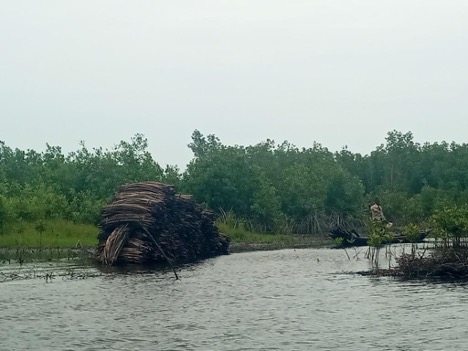
According to him, combining sensitization efforts and alternative livelihood provision will go a long way to slow the loss of mangroves.
“The people were harvesting the mangroves for subsistence, for charcoal and building. They clear whole areas and make the lands bare. We use drama and video screening to help them know the importance of mangroves in helping in climate change mitigation.”
The heavy reliance on mangroves for fuel wood and a source of livelihood for many locals along Ghana’s coast continues to counter restoration and conservation efforts by different non-governmental organizations working to protect the environment.
Nortey adds that community folks are encouraged to use of fuel effective cook stoves as alternatives to mangroves.
Bright Adzagba, manager of a local NGO, Keta Ramsar Center describes the indiscriminate mangrove cutting in the area as challenging. His organization has been working to conserve mangroves in the area but understandably it’s not been a walk in the park because people’s livelihoods depend on it.
Large areas of land covered with mangroves within the ramsar zone are owned by private individuals and families and so it has been difficult regulating its cutting.
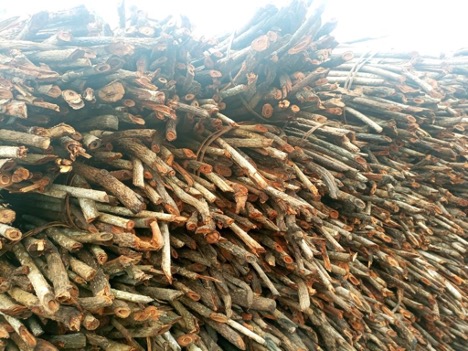
“Since people depend on it as a source of livelihood and the government cannot control because they are private lands, the harvesting persists. Most of the communities here are known for farming and fishing. Some of the residents have learnt to cultivate the mangroves but after maturity they cut it for sale,” he said.
Through extensive sensitization campaigns in schools, markets, and on local media, he hopes the situation will change but insists that alternative sources of livelihoods like fish farming and mangrove oyster farming must be found for residents to ensure that success of any conservation project.
“As a tree that supports the ecosystem, more attention needs to be paid to mangroves. A lot of NGOs like mine are working to conserve mangroves but with our system where families that own the land decide what to do with it, they [NGOs] must convince the families and get the community’s participation in their projects,” Adzagba says.
His organization and others like Arocha Ghana and Hen Mpoano have been engaging in seedling planting drives.
The effects of unsustainable mangrove harvesting aren’t lost on community folks. At least within the Keta RAMSAR enclave and the Amanzule RAMSAR enclave, artisanal fisher folk have witnessed a decline in their catch.

Areas known for collecting crab, shellfish and shrimps barely have these aquatic resources for people who depend on them for livelihood or personal consumption. Paapa Wusi, an artisanal fisherman in the Greater Amanzule area who has received education on mangrove conservation said he has observed that they are now able to harvest more fishes in areas where lost mangroves have been replanted.
“We were told that the reason for the low fish catch was because the mangroves that provided a safe place for fishes to spawn have been cut and truly since the mangroves have been replanted, more about two years now, I can say there has been an improvement,” he said.
His reality is similar to that of others fisherfolk in the Keta RAMSAR area.
Nearly 10 percent of Ghana’s population depends directly on the fisheries sector to survive, highlighting the cascading effect indiscriminate mangrove harvesting has on the Ghanaian population and by extension its economy.
Besides the effects on fishing, some communities within the Keta Ramsar enclave have been suffering serious coastal erosion and flooding as a result of unsustainable mangrove harvesting.
I met Raphael Ahiakpe, the Ghana country director for Sea Water Solutions at Attorkor in the Volta Region.
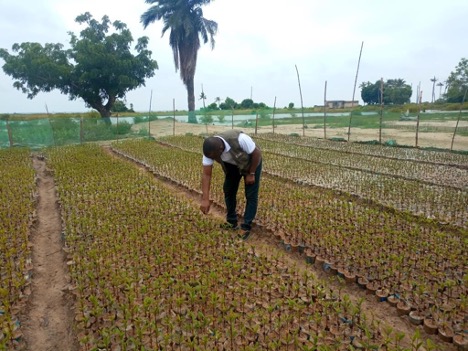
On a sizeable swathe of land in the area, more than 60,000 mangrove seedlings were being nurtured by his organization for later planting in the open field.
The organization has been brainstorming various options for protecting mangroves as part of a bigger project that it hopes to be replicated nationwide to protect the endangered tree species.
At Fiahor, on one of its project sites within the Keta ramsar enclave, Sea Water Solutions has planted over 100,000 mangroves and has a 200,000 capacity nursery in the works for what they hope would revolutionize the way mangroves are managed in the country due to their significance to the environment.

Ahiakpe said community involvement has been key to the organization’s achievements.
“You are likely to fail if you don’t get them [community] involved. No man will stay and see himself go hungry when they can go cut mangroves and get satisfied. You can’t say you are ignoring their needs in terms of benefiting from mangroves then succeed in growing mangroves. You need a balance. That is why you need to educate them and, also get initiatives that provide them an alternative source of livelihood such as tilapia farming,” he said.
“If we succeed in this initiative, we are going to restore the lagoon and those who depend on it for fishing will see some improvement,” Ahiakpe added.
Hen Mpoano’s imitative in the Western Region has been ongoing since 2014 and has seen some significant impact.
After exposing key individuals in the target communities to sustainable mangrove harvesting practices like replanting, the NGO has assisted the community folks to constitute local watchdog committees to ensure conservation of the important trees.
“Our work involves the relevant stakeholders like the chiefs, so it is like a communal thing. We have committees in these communities endorsed by the traditional authorities to protect the mangroves,” Nortey said.
By the end of 2022 the organization is hoping to plant 200,000 mangrove seedlings covering 50 hectares of degraded mangrove forests within the Greater Amanzule Wetlands in the Western Region alone.
It has put up nurseries where mangroves are being nursed by locals at a fee for later planting in the open field where mangroves have been indiscriminately harvested.
The project hopes to sequester 1.8 million megagram carbon in the long-term.
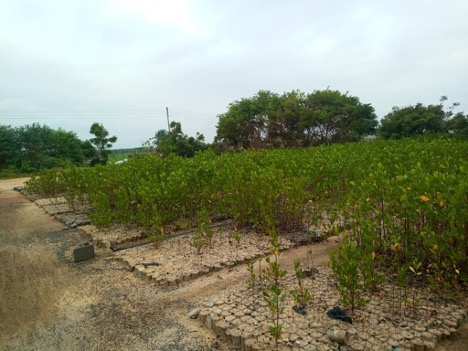
Sea Water Solution is also hoping to trade carbon credit if its project goes well particularly after running its Ada and Fiaxor fields at full capacity in future.
The NGOs say they are willing to make the sacrifices to lead efforts at rallying communities to conserve mangroves while providing locals with alternative livelihoods due to the strong beliefs about the importance of mangroves to the environment.
This story was produced with support from the Internews’s Earth Journalism Network.
–
By: Jonas Nyabor, Ghanaian journalist and fact-checker | jnyabor@gmail.com


